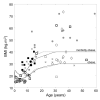A new highly penetrant form of obesity due to deletions on chromosome 16p11.2
- PMID: 20130649
- PMCID: PMC2880448
- DOI: 10.1038/nature08727
A new highly penetrant form of obesity due to deletions on chromosome 16p11.2
Abstract
Obesity has become a major worldwide challenge to public health, owing to an interaction between the Western 'obesogenic' environment and a strong genetic contribution. Recent extensive genome-wide association studies (GWASs) have identified numerous single nucleotide polymorphisms associated with obesity, but these loci together account for only a small fraction of the known heritable component. Thus, the 'common disease, common variant' hypothesis is increasingly coming under challenge. Here we report a highly penetrant form of obesity, initially observed in 31 subjects who were heterozygous for deletions of at least 593 kilobases at 16p11.2 and whose ascertainment included cognitive deficits. Nineteen similar deletions were identified from GWAS data in 16,053 individuals from eight European cohorts. These deletions were absent from healthy non-obese controls and accounted for 0.7% of our morbid obesity cases (body mass index (BMI) >or= 40 kg m(-2) or BMI standard deviation score >or= 4; P = 6.4 x 10(-8), odds ratio 43.0), demonstrating the potential importance in common disease of rare variants with strong effects. This highlights a promising strategy for identifying missing heritability in obesity and other complex traits: cohorts with extreme phenotypes are likely to be enriched for rare variants, thereby improving power for their discovery. Subsequent analysis of the loci so identified may well reveal additional rare variants that further contribute to the missing heritability, as recently reported for SIM1 (ref. 3). The most productive approach may therefore be to combine the 'power of the extreme' in small, well-phenotyped cohorts, with targeted follow-up in case-control and population cohorts.
Figures


References
-
- Walley AJ, Asher JE, Froguel P. The genetic contribution to non-syndromic human obesity. Nat. Rev. Genet. 2009;10:431–442. - PubMed
-
- Stutzmann F, et al. Loss-of-function mutations in SIM1 cause a specific form of Prader-Willi-like syndrome. Diabetologia. 2009;52:S104.
-
- Froguel P, Blakemore AIF. The Power of the Extreme in Elucidating Obesity. New Eng. J. Med. 2008;359:891–893. - PubMed
Publication types
MeSH terms
Associated data
- Actions
Grants and funding
- R01 MH063706/MH/NIMH NIH HHS/United States
- 082390/WT_/Wellcome Trust/United Kingdom
- G0600331/MRC_/Medical Research Council/United Kingdom
- R01 HL087679/HL/NHLBI NIH HHS/United States
- 079534/WT_/Wellcome Trust/United Kingdom
- 5R01MH63706:02/MH/NIMH NIH HHS/United States
- 1RL1MH083268-01/MH/NIMH NIH HHS/United States
- G0900554/MRC_/Medical Research Council/United Kingdom
- 077014/WT_/Wellcome Trust/United Kingdom
- G0500539/MRC_/Medical Research Council/United Kingdom
- 089061/WT_/Wellcome Trust/United Kingdom
- G0600331(77796)/MRC_/Medical Research Council/United Kingdom
- 5R01HL087679-02/HL/NHLBI NIH HHS/United States
- RL1 MH083268/MH/NIMH NIH HHS/United States
LinkOut - more resources
Full Text Sources
Other Literature Sources
Medical
Molecular Biology Databases

